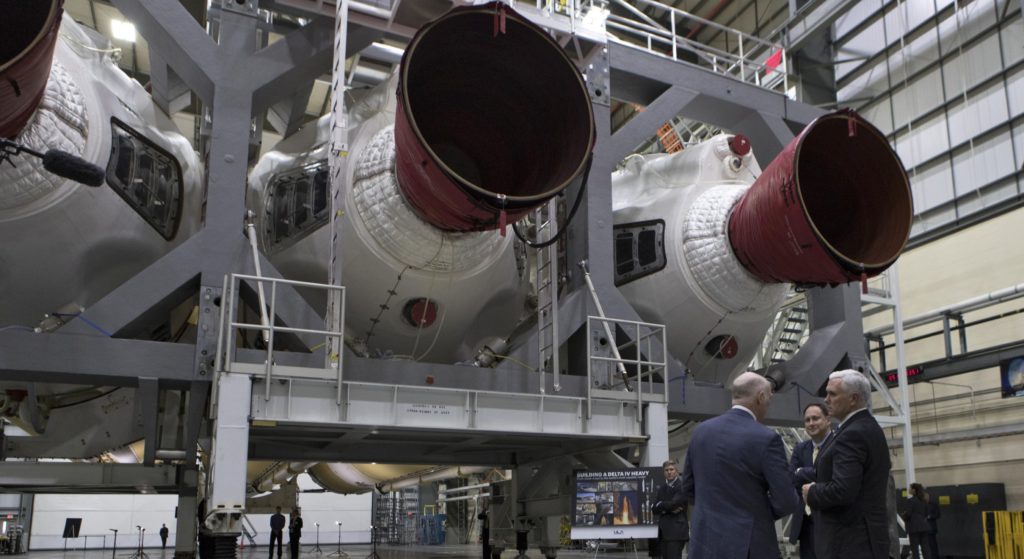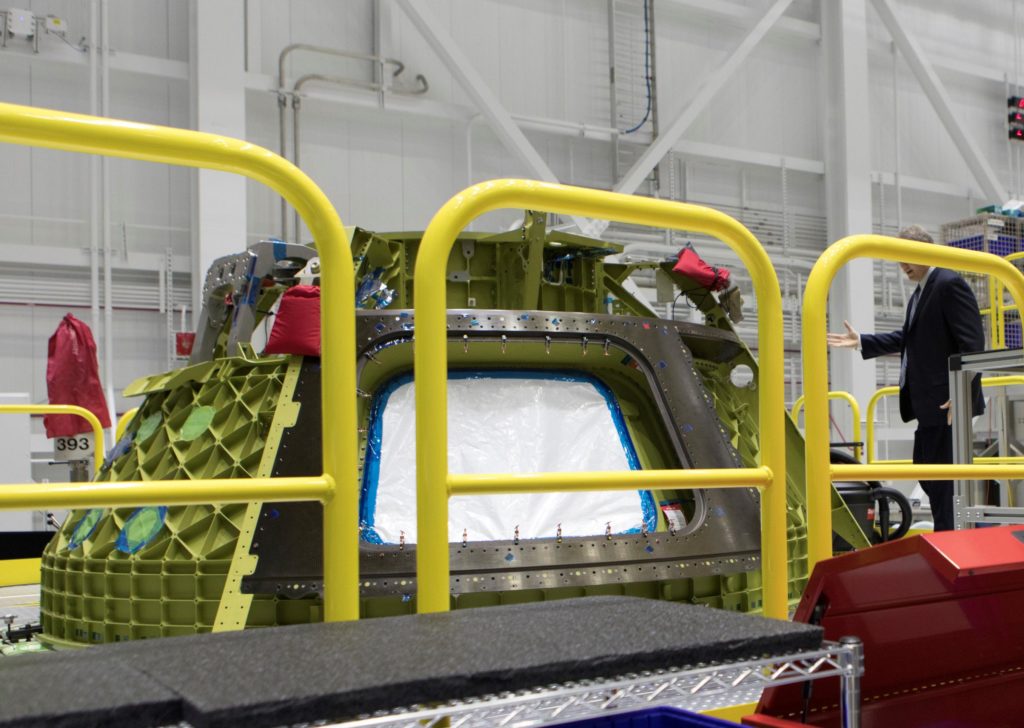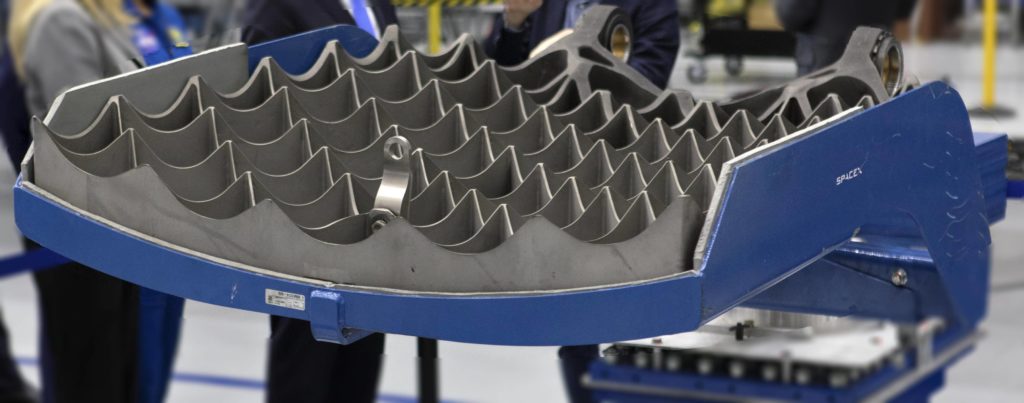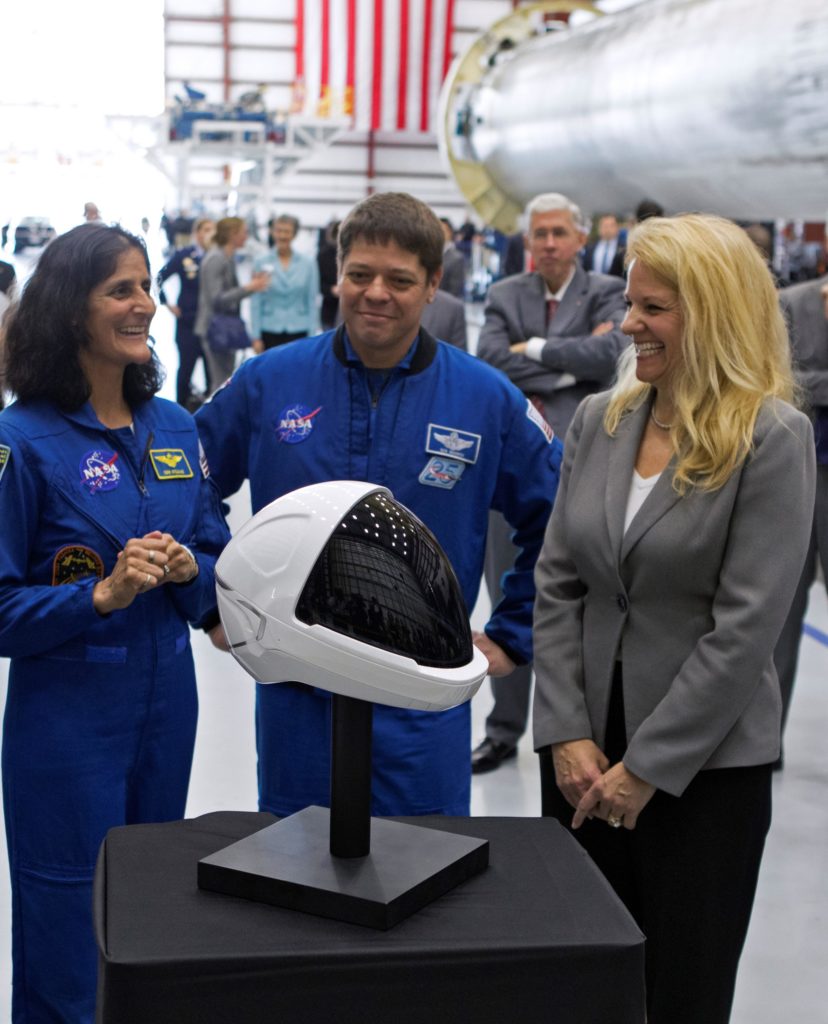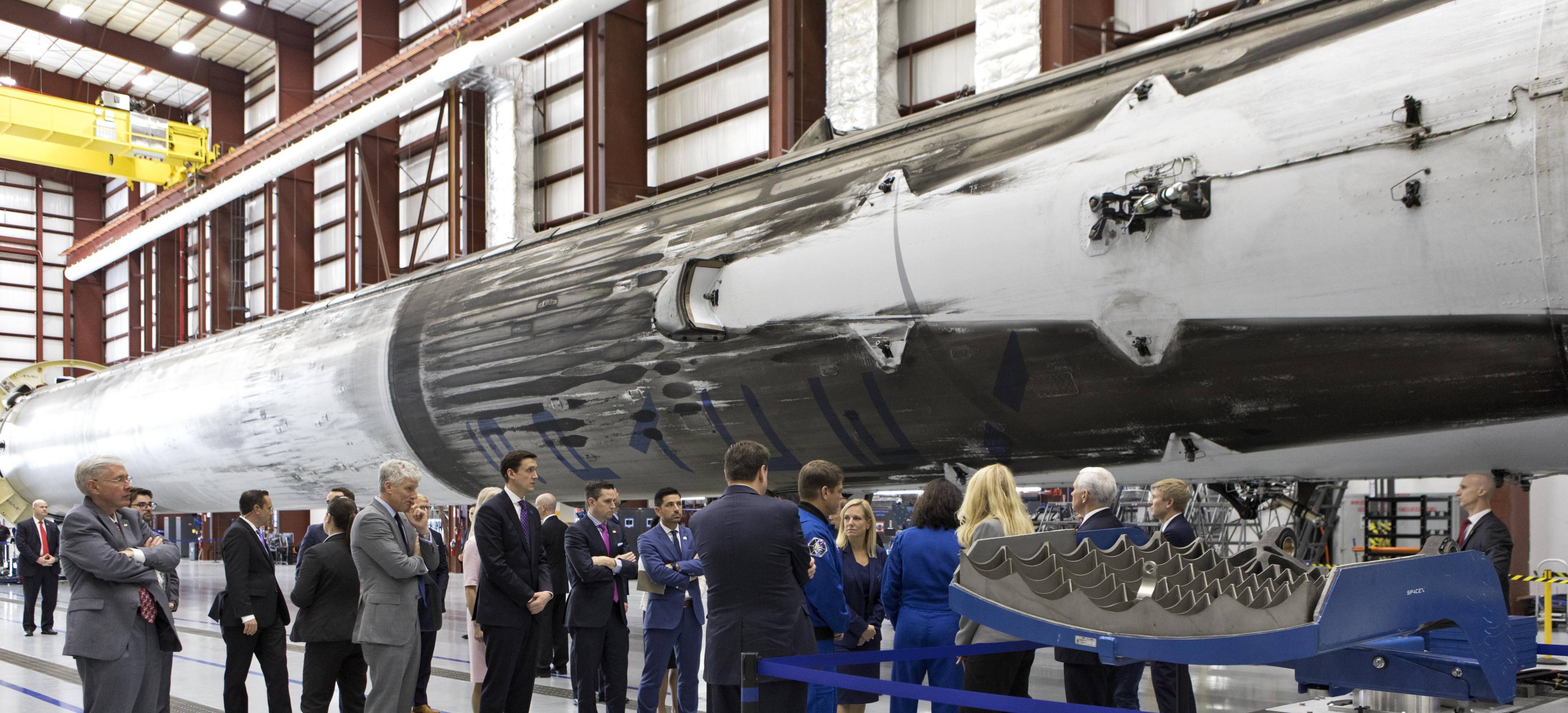

News
SpaceX shows off Starman helmet and Falcon Heavy to political VIPs
In the wake of the rather odd second meeting of the US National Space Council (NSC), a NASA photographer stationed at Kennedy Space Center documented a number of tours given by some of the companies mentioned in the proceedings. VIPs who attended the NSC were allowed to get up close and personal to rocket hardware in facilities owned and operated by SpaceX, Blue Origin, Boeing, the United Launch Alliance (ULA), and others, and in a few cases provided some unique views of those same facilities.
RELATED: SpaceX vs. Blue Origin: The bickering titans of new space
Humorously enough, those tours – at least as seen through the lenses of NASA photographer Kim Shiflett – acted as a generally accurate thematic representation of each company. ULA walked VIPs through their Delta IV Heavy integration facility, ready for the launch of a NASA spacecraft tasked with traveling closer to the sun than any vehicle before it – the impressive but oft-maligned rocket’s first launch in nearly two years.
Boeing displayed some of their Starliner hardware, hoped to carry their first crew to the International Space Station in very late 2018 or early 2019. Blue Origin showed off a massive factory – intended to eventually manufacture their orbital New Glenn rocket – that was, by all appearances, almost completely empty, aside from a flight-proven New Shepard and boilerplate capsule now on display in the lobby.
- ULA president and CEO Tory Bruno, left leads a tour of the Delta IV Heavy rocket for VP Mike Pence. (NASA)
- Boeing, one of the two companies that comprise ULA, gave NSC VIPs a tour of the facility where they are assembling Starliner crew capsules. (NASA)
- Blue Origin’s seemingly empty New Glenn factory. The massive rocket is hoped to complete its first launch NET 2020. (NASA)
- Blue Origin has had some success with its New Shepard suborbital rocket reuse program, although dramatically different from New Glenn. (NASA)
SpaceX, however, undertook the (admittedly less than titanic) feat of overshadowing its fellow aerospace companies. Something like 80% coincidence and 20% theatrics, SpaceX’s displays included two of the just-launched and just-landed Falcon Heavy boosters – one accessible by all at the Kennedy Space Center Visitor Center, the other recently shuttled into the company’s facilities at Pad 39A. While the company appears not to have opened their second LC-40 pad for tours this time around, Space Council VIPs were given a unique mass-tour of Pad 39A’s Horizontal Integration Facilities, chock full of flight-proven orbital rockets and components.
- Titanium grid fins complete the highly reusable changes to Block 5 of Falcon 9. (NASA)
- A unique perspective of SpaceX’s upgraded grid fin – dwarfing its human onlookers. (NASA)
- Shotwell, pictured on the right, spoke in depth about SpaceX’s profitability and synergies with Tesla’s battery expertise. (NASA)
- (NASA)
On display was the second Falcon Heavy side booster, a Falcon 9-equivalent first stage that took part in the inaugural launch of the massive rocket just two weeks before, as well as one of that booster’s highly valuable titanium grid fins, providing a unique sense of scale (spoiler: they’re colossal). Further, after what can only be described as Starman’s iconic global debut, SpaceX brought along the helmet of one of their slick internally-designed spacesuits, going so far as to let members of the tour – including the Secretary of the Air Force – briefly try it on for themselves.
.@NASA I’m ready to go. When’s the next launch? pic.twitter.com/XC21RFEw5C
— Office of the Secretary of the Air Force (@SecAFOfficial) February 21, 2018
Despite the baffling fact that none of the actual hardware developers that gave tours after had seats on either of the two panels that spoke before the Council, it’s great to see SpaceX flaunt at least a portion of its extraordinary and praiseworthy achievements in the last few months alone.
Whether or not you resent some of the politicking or the actors involved in the spectacle, the general theme of reducing and improving regulatory burdens on US aerospace companies is one of the very few places where there is actually some truth to the negativity. Jingoistic China-bashing and hyperbole aside, some of the panelists and councilmembers made reasonable points about the state of spaceflight regulation, and some of their recommendations may actually benefit companies like Blue Origin, ULA, and SpaceX – at least eventually.
Catch our live, behind-the-scenes coverage of these exciting events through the eyes of our amazing photographers on both coasts.
Teslarati – Instagram – Twitter
Tom Cross – Twitter
Pauline Acalin – Twitter
Eric Ralph – Twitter
Elon Musk
Tesla investors will be shocked by Jim Cramer’s latest assessment
Jim Cramer is now speaking positively about Tesla, especially in terms of its Robotaxi performance and its perception as a company.

Tesla investors will be shocked by analyst Jim Cramer’s latest assessment of the company.
When it comes to Tesla analysts, many of them are consistent. The bulls usually stay the bulls, and the bears usually stay the bears. The notable analysts on each side are Dan Ives and Adam Jonas for the bulls, and Gordon Johnson for the bears.
Jim Cramer is one analyst who does not necessarily fit this mold. Cramer, who hosts CNBC’s Mad Money, has switched his opinion on Tesla stock (NASDAQ: TSLA) many times.
He has been bullish, like he was when he said the stock was a “sleeping giant” two years ago, and he has been bearish, like he was when he said there was “nothing magnificent” about the company just a few months ago.
Now, he is back to being a bull.
Cramer’s comments were related to two key points: how NVIDIA CEO Jensen Huang describes Tesla after working closely with the Company through their transactions, and how it is not a car company, as well as the recent launch of the Robotaxi fleet.
Jensen Huang’s Tesla Narrative
Cramer says that the narrative on quarterly and annual deliveries is overblown, and those who continue to worry about Tesla’s performance on that metric are misled.
“It’s not a car company,” he said.
He went on to say that people like Huang speak highly of Tesla, and that should be enough to deter any true skepticism:
“I believe what Musk says cause Musk is working with Jensen and Jensen’s telling me what’s happening on the other side is pretty amazing.”
Tesla self-driving development gets huge compliment from NVIDIA CEO
Robotaxi Launch
Many media outlets are being extremely negative regarding the early rollout of Tesla’s Robotaxi platform in Austin, Texas.
There have been a handful of small issues, but nothing significant. Cramer says that humans make mistakes in vehicles too, yet, when Tesla’s test phase of the Robotaxi does it, it’s front page news and needs to be magnified.
He said:
“Look, I mean, drivers make mistakes all the time. Why should we hold Tesla to a standard where there can be no mistakes?”
It’s refreshing to hear Cramer speak logically about the Robotaxi fleet, as Tesla has taken every measure to ensure there are no mishaps. There are safety monitors in the passenger seat, and the area of travel is limited, confined to a small number of people.
Tesla is still improving and hopes to remove teleoperators and safety monitors slowly, as CEO Elon Musk said more freedom could be granted within one or two months.
News
Tesla launches ultra-fast V4 Superchargers in China for the first time
Tesla has V4 Superchargers rolling out in China for the first time.

Tesla already has nearly 12,000 Supercharger piles across mainland China. However, the company just initiated the rollout of the ultra-fast V4 Superchargers in China for the first time, bringing its quick-charging piles to the country for the first time since their launch last year.
The first batch of V4 Superchargers is now officially up and running in China, the company announced in a post on Chinese social media outlet Weibo today.
The company said in the post:
“The first batch of Tesla V4 Superchargers are online. Covering more service areas, high-speed charging is more convenient, and six-layer powerful protection such as rain and waterproof makes charging very safe. Simultaneously open to non-Tesla vehicles, and other brands of vehicles can also be charged. There are more than 70,000 Tesla Superchargers worldwide. The charging network layout covers 100% of the provincial capitals and municipalities in mainland China. More V4 Superchargers will be put into use across the country. Optimize the charging experience and improve energy replenishment efficiency. Tesla will accompany you to the mountains, rivers, lakes, and seas with pure electricity!”
The first V4 Superchargers Tesla installed in China are available in four cities across the country: Shanghai, Zhejiang, Gansu, and Chongqing.

Credit: Tesla China
Tesla has over 70,000 Superchargers worldwide. It is the most expansive and robust EV charging network in the world. It’s the main reason why so many companies have chosen to adopt Tesla’s charging connector in North America and Europe.
In China, some EVs can use Tesla Superchargers as well.
The V4 Supercharger is capable of charging vehicles at speeds of up to 325kW for vehicles in North America. This equates to over 1,000 miles per hour of charging.
Elon Musk
Elon Musk hints at when Tesla could reduce Safety Monitors from Robotaxi
Tesla could be reducing Safety Monitors from Robotaxi within ‘a month or two,’ CEO Elon Musk says.

Elon Musk hinted at when Tesla could begin reducing Safety Monitors from its Robotaxis. Safety Monitors are Tesla employees who sit in the front passenger seat during the driverless rides, and are there to ensure safety for occupants during the earliest rides.
Tesla launched its Robotaxi fleet in Austin last Sunday, and after eight days, videos and reviews from those who have ridden in the driverless vehicles have shown that the suite is safe, accurate, and well coordinated. However, there have been a few hiccups, but nothing that has put anyone’s safety in danger.
A vast majority — close to all of the rides — at least according to those who have ridden in the Robotaxi, have been performed without any real need for human intervention. We reported on what was the first intervention last week, as a Safety Monitor had to step in and stop the vehicle in a strange interaction with a UPS truck.
Watch the first true Tesla Robotaxi intervention by safety monitor
The Tesla and UPS delivery truck were going for the same street parking space, and the Tesla began to turn into it. The UPS driver parallel parked into the spot, which was much smaller than his truck. It seemed to be more of an instance of human error instead of the Robotaxi making the wrong move. This is something that the driverless cars will have to deal with because humans are aggressive and sometimes make moves they should not.
The Safety Monitors have not been too active in the vehicles. After all, we’ve only seen that single instance of an intervention. There was also an issue with the sun, when the Tesla braked abnormally due to the glare, but this was an instance where the car handled the scenario and proceeded normally.
With the Robotaxi fleet operating impressively, some are wondering when Tesla will begin scaling back both the Safety Monitors and Teleoperators that it is using to ensure safety with these early rides.
CEO Elon Musk answered the inquiry by stating, “As soon as we feel it is safe to do so. Probably within a month or two.”
As soon as we feel it is safe to do so.
Probably within a month or two. We continue to improve the Tesla AI with each mile driven.
— Elon Musk (@elonmusk) June 30, 2025
Musk’s response seems to confirm that there will be fewer Teleoperators and Safety Monitors in the coming months, but there will still be some within the fleet to ensure safety. Eventually, that number will get to zero.
Reaching a point where Tesla’s Robotaxi is driverless will be another significant milestone for the company and its path to fully autonomous ride-sharing.
Eventually, Tesla will roll out these capabilities to consumer-owned vehicles, offering them a path to generate revenue as their car operates autonomously and completes rides.
For now, Tesla is focusing on perfecting the area of Austin where it is currently offering driverless rides for just $4.20 to a small group of people.
-

 News5 days ago
News5 days agoTesla Robotaxi’s biggest challenge seems to be this one thing
-

 News2 weeks ago
News2 weeks agoTesla confirms massive hardware change for autonomy improvement
-

 Elon Musk2 weeks ago
Elon Musk2 weeks agoElon Musk slams Bloomberg’s shocking xAI cash burn claims
-

 News2 weeks ago
News2 weeks agoTesla China roars back with highest vehicle registrations this Q2 so far
-

 News2 weeks ago
News2 weeks agoTesla features used to flunk 16-year-old’s driver license test
-

 News2 weeks ago
News2 weeks agoTesla dominates Cars.com’s Made in America Index with clean sweep
-

 News2 weeks ago
News2 weeks agoTexas lawmakers urge Tesla to delay Austin robotaxi launch to September
-

 News2 weeks ago
News2 weeks agoTesla’s Grok integration will be more realistic with this cool feature

